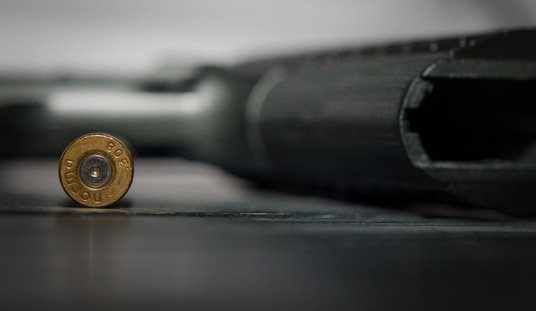The Taurus Model 4410 Judge .410/45 Colt revolver makes for an interesting topic. Why did Taurus introduce a five-shot, three inch barreled, double-action revolver into the personal defense market? It seems counter-intuitive, especially when compared against polymer framed, high-capacity, accessory laden semi-automatic pistols or tuned 1911s that can shoot one inch groups at 50 yards. None of these features guarantee success in a close quarter defensive encounter. Oft repeated statistics show that the majority of defensive shootings take place under 7 feet. Put another way, most gunfights take place in an area the size of a dining room rug. Unfortunately, I can not remember the source of this great quote that puts everything in perspective: "Stopping power and reliability is a premium when forced to fight." The Taurus 4410 Judge delivers this premium in an affordable package. The Taurus’s .410 chambering loaded with buckshot is devastating at close range. The Judge’s revolver action eliminates any chance of a slide coming into contact with an object during a close encounter, and inducing a malfunction. Taurus got it right, in designing the Model 4410 Judge for self-defense.
"What a quaint pistol," was my first impression of the Judge. I thought, at best it was an oddity, with its ability to chamber both a .45 Colt pistol round and a 2½ inch 410 shotgun shell. Upon further evaluation, I came to the conclusion the Taurus Model 4410 Judge is a viable defensive weapon. The primary chambering will be the .410 shotgun. The 45 Colt is a time proven cartridge, but there is no need carrying a revolver the size of the Judge to use the .45 Colt. Versatility does not end at the dual chambering. The .410 offers multiple loads ranging from slugs (I would use .45 Colt if contemplating solitary projectiles), buckshot (my favorite), and numerous birdshot sizes.
This article will concentrate on the Judge’s defensive capabilities against two legged predators. I must mention, however, the Taurus 4410 revolver would make a handy backpack or trail weapon considering its ammunition versatility. My testing was limited to #4 & #6 shot (terminal ballistic reasons), buckshot, and Black Hills .45 Colt ammunition. The #00 buckshot, launching three (3) .33 caliber balls with each trigger pull, is the optimum defensive load in my opinion. In the past, I carried a .410/45 Colt derringer loaded with buckshot. The capability of inflicting multiple wound channels, each similar in size to a 9mm round, gave comfort when carrying the derringer. Admittedly, accurate fire was an arm’s length affair. I quit using the derringer due to its limited accuracy range and I converted to a Glock 27. The new Taurus offering is a more viable alternative for people wanting to utilize a "shotgun" pistol. The Judge’s fiber optic front sight combined with fixed rear notch sight enables accurate shooting. The full-size "ribber" grip, a Taurus signature feature, also aids in placing rounds on target, not to mention taming recoil. The Judge is a definite improvement over my derringer experience.
The Judge is derived from the Taurus compact revolver frame. Do not be misled by this. The Judge definitely does not have a .38 snubby profile. The oversized cylinder needed to accommodate the 2 ½ inch .410 shells rules this out. The Judge is not a "concealable" revolver model, but should be classified as a defensive pistol. My model featuring matte stainless steel construction weighs in at 29 oz empty. My suggestion for concealable carry with the Judge is a fanny pack. Some of our readers will feel this is a less than ideal way of practicing concealed carry. However, an outside the pants holster with the revolver’s grip printing under the outer garment is not very productive either. Of course, specific situations will dictate various concealed carry methods. Flexibility is the key to success.
TV advertisements and Taurus webpage features the Judge loaded with birdshot in a simulated response to a carjacking. I wonder, tongue-in-cheek, if this is because the pattern displayed on the target is so visually impressive. I have no doubt a potential carjacker would turn away after a load of birdshot is delivered to his/her upper torso allowing the victim to drive away. My concern lies in a less mobile encounter on the street or in the home where escape will not be as easy as driving away. Buckshot’s lethality is based on multiple wound tracks penetrating the targets torso simultaneously. Birdshot has its utility if over-penetration is a concern within a home, but a price is paid in terminal ballistic performance and effective range. Various studies indicate #00 buckshot at close range will penetrate 12 inches of ballistic gelatin, which is enough to reach vital organs, whereas #4 or #6 shot penetrates 6 inches at best. An added caveat is that these studies were conducted with long barreled shotguns. The Judge’s short barrel, combined with rifling, lends itself to less velocity and a quicker dispersion of the shot column versus standard length choked barrels. The birdshot certainly will be painful and cause tissue damage, but will not reliably shutdown a determined adversary.
 I tested the Judge at 2, 7, & 10 yards against steel poppers and paper targets utilizing various shotgun and .45 Colt loadings. My testing concentrated on the .410’s capabilities. As mentioned earlier in the article, I feel the .45Colt is ancillary to the .410 chambering. One buckshot brand proved temperamental when inserting into the Taurus’ cylinder. I reasoned this was due to manufacturing methods of the plastic hulls containing the round buckshot. Empty hulls of the fired buckshot shells extracted easily. One interesting aspect discovered with the Judge firing shotshells is how quickly the birdshot disperses after leaving the barrel. Other articles on the Judge claim it is the right hand rifling twist the shot column endures as it exits the pistol. I do not contest this, but I think the dispersion is a natural consequence of firing shotgun shells out of a 3 inch unchoked barrel. A good test for my theory would be to fire a 6 inch barreled version of the Judge for comparison. The .45 Colt proved accurate against the 15 yard steel popper targets, even with the long "jump" required for the bullet leaving the cylinder of the Judge before engaging the barrel’s rifling. The .45 Colt rounds were a relief, in terms of recoil, compared to the .410 shotshells. The Black Hills load reliably put down steel man targets out to 25 yards and demands respect further out depending on shooter proficiency. This is well beyond any shotshell range. The Black Hills .45 Colt 250 grn lead slug leaves the muzzle at approximately 700 fps and offers historically reliable terminal performance. The .45 Colt option adds great versatility to the Judge’s repertoire.
I tested the Judge at 2, 7, & 10 yards against steel poppers and paper targets utilizing various shotgun and .45 Colt loadings. My testing concentrated on the .410’s capabilities. As mentioned earlier in the article, I feel the .45Colt is ancillary to the .410 chambering. One buckshot brand proved temperamental when inserting into the Taurus’ cylinder. I reasoned this was due to manufacturing methods of the plastic hulls containing the round buckshot. Empty hulls of the fired buckshot shells extracted easily. One interesting aspect discovered with the Judge firing shotshells is how quickly the birdshot disperses after leaving the barrel. Other articles on the Judge claim it is the right hand rifling twist the shot column endures as it exits the pistol. I do not contest this, but I think the dispersion is a natural consequence of firing shotgun shells out of a 3 inch unchoked barrel. A good test for my theory would be to fire a 6 inch barreled version of the Judge for comparison. The .45 Colt proved accurate against the 15 yard steel popper targets, even with the long "jump" required for the bullet leaving the cylinder of the Judge before engaging the barrel’s rifling. The .45 Colt rounds were a relief, in terms of recoil, compared to the .410 shotshells. The Black Hills load reliably put down steel man targets out to 25 yards and demands respect further out depending on shooter proficiency. This is well beyond any shotshell range. The Black Hills .45 Colt 250 grn lead slug leaves the muzzle at approximately 700 fps and offers historically reliable terminal performance. The .45 Colt option adds great versatility to the Judge’s repertoire.
The .410 #4 and #6 shotshells patterned densely at two yards keeping the shot column inside the B27 target’s 9 ring. Beyond seven yards, I would deem the #4 and #6 shotshells ineffective in terms of personal defense, due to dispersion of the shot. The #00 buckshot showed six inch dispersion at two yards and kept all pellets in the 8 ring of a B27 silhouette target at seven yards. At 10 yards, the buckshot started showing signs of unreliability with pellets off target, and past 15 yards the buckshot was hopeless in predicting any pellets on target.
One misperception needs to be cleared up quickly with the reader. The Judge is a pistol in terms of use and lethality, not a short barreled shotgun. The .410 chambering is no street sweeper and aimed fire is still a must. The use of .410 shotshells or buckshot dictates ranges of 10 yards or less for efficient use. However, the buckshot loading has few rivals when used within this parameter. The Judge offers a person a better chance of hitting an adversary with its firepower "cone" compared to a centerfire pistol round, especially against moving targets. The .45 Colt pistol round is a single projectile with a minimal spatial cross-section, whereas the three buckshot pellets disperse into a six inch pattern even at close range. The six inch diameter pattern translates into one square foot of area that a target can be struck. Psychologically, the Judge is re-assuring. This is the advantage offered with the Judge and any other shotgun for that matter. The Judge fulfills its design intentions as a close range defensive firearm. Heed this and a user will find themselves well armed in any jungle–asphalt or natural.
Special Thanks to:
Stonewall Arms LLC.
2438 Valley Ave
Winchester, VA 22601
540-535-2190
www.stonewallarms.com
Photo by Keith Kilmer.








Join the conversation as a VIP Member